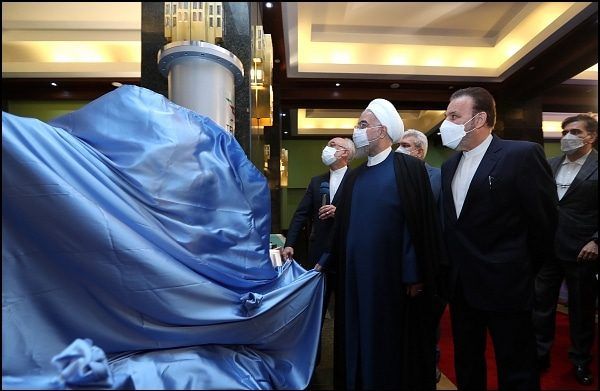Preventing an accidental nuclear crisis in Iran and beyond
By Samuel M. Hickey | October 11, 2021
 Iranian President Rouhani visiting the exhibition of nuclear achievements. Credit: Official website of the President of the Islamic Republic of Iran. https://president.ir/en/120598
Iranian President Rouhani visiting the exhibition of nuclear achievements. Credit: Official website of the President of the Islamic Republic of Iran. https://president.ir/en/120598
There has been no sign as to when nuclear talks with Iran may recommence. But after weeks of consultations, Iran and the International Atomic Energy Agency (IAEA) have reached a deal on “the way and the timing” for UN nuclear inspectors to service cameras installed at Iran’s nuclear facilities. This patchwork agreement has kept alive the possibility of recovering a complete picture of Iran’s nuclear program and of reviving the Iran nuclear deal since Iran cut inspector access in February. It is also the first real sign of cooperative engagement by Iran since President Ebrahim Raisi came to power in August.
The Iran nuclear deal, also known as the Joint Comprehensive Plan of Action, is the latest experiment in how much UN nuclear inspector access states will tolerate. However, it is under exceptional stress from those who believe military coercion is more effective than systems of denial in stemming proliferation. Days after the least competitive presidential election in the Islamic Republic’s history, a drone attack at a centrifuge production facility on June 23 damaged the IAEA’s monitoring and surveillance equipment. While the Israeli government did not comment on the attack, the Iran Centrifuge Technology Company, located in the city of Karaj, was reportedly “on a list of targets that Israel presented to the Trump administration early last year.” Now, Iran has allowed the IAEA to service cameras in every location but the Karaj site.
Acts of sabotage are diametrically opposed to the global nuclear verification regime because states need to believe that punishment will cease if they comply with the agreed-to framework. Further, failure to revive the nuclear deal could remove the possibility of applying the verification tools gained to other proliferation challenges like North Korea or the next nuclear threshold state. The loss of these techniques would undermine efforts to improve the global nonproliferation regime. As the United States’ experiences in leaving Afghanistan make clear, accurate intelligence is critical to making informed decisions and avoiding a crisis. The wrong assumptions can have dire consequences.
Verification evolution: Iraq and the old gold standard. The current nuclear verification protocols are the strongest in history and prioritize the non-diversion of nuclear materials over sovereign jurisdiction; however, many of these legal instruments were born out of crisis and remain voluntary, not mandatory. For instance, the investigative powers of the IAEA were substantially expanded by the creation of the Additional Protocol in 1997 to ensure that states’ declarations are both correct and complete.
This protocol has its origin in the Middle East. In the aftermath of the 1991 Persian Gulf War, the IAEA realized it could not detect if nuclear material used in a civilian nuclear program was diverted to a covert nuclear weapons program. International inspectors were stunned to find Iraq’s nuclear program, under Saddam Hussein, could produce enough fissile material for a nuclear weapon in 12-18 months, instead of the previous prediction of four to five years. This revelation was the impetus to create the Model Additional Protocol in May 1997, which substantially increased the IAEA’s oversight of a comprehensive safeguards agreement.
It took the case of a militarily defeated country to create conditions for more vigorous oversight by the IAEA of a clandestine nuclear program with only a general safeguards agreement. The honor code previously relied upon for monitoring international safeguards was shattered by the Iraq experience. Still, the IAEA has no power to enforce safeguards or penalize those who fail to comply; it can exercise only the authority it is given. These limitations have led some states to act against the assurances of the IAEA with disastrous consequences.
Without access to the full range of data that would be available under a rigorous verification regime, the United States used unsubstantiated and incorrect intelligence claims to back its assertion that Iraq had resurrected its nuclear weapons program despite the assessment of the IAEA. The 2003 invasion would prove that Iraq had not, in fact, reconstructed its weapons program.
Today, 137 states have brought an Additional Protocol into force, but for those countries that have not accepted the protocol—like Argentina, Brazil, Egypt and Saudi Arabia—no one can be sure whether their civilian nuclear programs divert materials for weapons use. In the case of Iran, the Additional Protocol was implemented in 2015 on a provisional basis as outlined in the Iran nuclear deal and planned to be fully adopted in 2023. It has not been fully implemented since late February.
The additions of the Iran nuclear deal. The consistent revision and evolution of the global nuclear order is arguably its greatest success. The adoption of the comprehensive safeguards agreement, Additional Protocol, and the numerous multilateral institutions to protect, restrict, and monitor all nuclear commerce have strengthened the confidence in IAEA assessment. But those mechanisms were not enough to satisfy concerns about the Iranian nuclear program. Despite its politicization in Congress, the Iran nuclear deal represents the next-generation nuclear verification design to prevent any country from cheating its way to a nuclear weapon in a hurry.
Specifically, the Iran nuclear deal caps the quantity and level of enrichment of uranium as well as the number and sophistication of the centrifuges that are operating and limits heavy water production. It also provides continuous monitoring of centrifuges and centrifuge rotor tubes, continuous access to Natanz, the monitoring of the production or acquisition of any uranium ore concentrate and enhanced managed access, meaning the IAEA can inspect a suspected violation.
The deal also instilled two key principles that should be universalized. First, a civilian nuclear program should be commensurate to its energy or related needs. Second, the IAEA has the right to monitor a ban on “weaponization” activities, which are activities related to developing or procuring equipment for developing nuclear weapons. This is the first agreement ever that defines a set of prohibited activities associated with weaponization, and it set up a procurement channel to monitor the materials and technologies Iran seeks to acquire that could be diverted to a secret program. These blocking efforts and verification tools are the most robust in the world, but extending the timeline for these activities, known as the sunset clauses, or applying them to other countries will require reviving the nuclear deal and preventing further acts of nuclear sabotage.
These measures, at least until the deal expires, will provide a high degree of confidence that weapons-related activity is not occurring. They could also be promoted as a model for other countries wanting to give confidence in the peaceful nature of their own nuclear facilities. Presently, the IAEA is investigating several locations for the presence of nuclear particles of “anthropogenic” origin, meaning materials that have been processed beyond their natural state, but this should not be sufficient grounds for losing monitoring altogether. Iran could assuage such concerns in the future through voluntary transparency, if it is sincere in its contention that it has halted progress toward nuclear weapons. It is in Iran’s national self-interest to assure the world they have no secret nuclear agenda.
Politicization of technical assurances. Imagine if every country in the world were subject to continuous monitoring of sensitive nuclear facilities and provided access upstream in the fuel cycle to activities such as mining, milling and conversion. Such access would demonstrably reduce the likelihood that materials gained for ostensibly civilian purposes could be siphoned off to a clandestine program. However, failure to revive the deal risks relegating these additional measures to history.
If the politics of the Iranian nuclear program are too challenging, then the new verification tools will not be useful to solve a real crisis if one crops up in Iran or elsewhere. The great arms control theorist and developer of game theory Thomas Schelling opened his book Arms and Influence with the reflection: “One of the lamentable principles of human productivity is that it is easier to destroy than to create.” Let’s hope the groundbreaking verification and monitoring tools of the Iran nuclear deal are not a casualty of human initiative.
Together, we make the world safer.
The Bulletin elevates expert voices above the noise. But as an independent nonprofit organization, our operations depend on the support of readers like you. Help us continue to deliver quality journalism that holds leaders accountable. Your support of our work at any level is important. In return, we promise our coverage will be understandable, influential, vigilant, solution-oriented, and fair-minded. Together we can make a difference.
Keywords: Iran, Iran nuclear deal, JCPOA, joint comprehensive plan of action, nonproliferation, nuclear risk, nuclear weapons
Topics: Nuclear Risk, Nuclear Weapons, Opinion















There was never any actual evidence of an actual nuclear weapons program in Iran (the worst found in Iran were “scattered and incomplete…feasibility studies”) and Iran had long offered better deals than the JCPOA, offers which the US either ignored or actively undermined, in order to maintain this manufactured pretext for the actual policy of imposing regime-change. This only backfired and resulted in an expansion of the nuclear program and increase in enrichment (as well as huge backlash of popularity with Iranian public opinion.) The idea that Iran was off making nukes but being restrained by sanctions or the JCPoA… Read more »